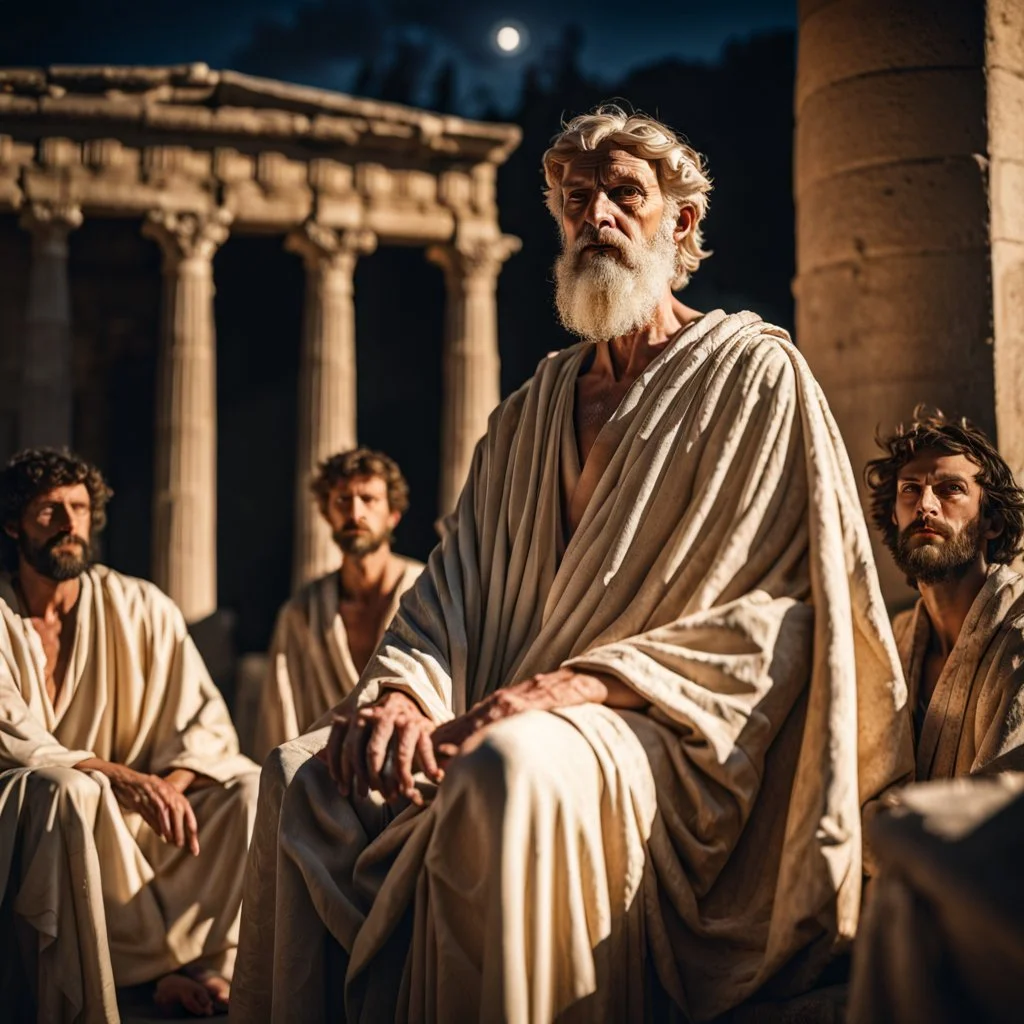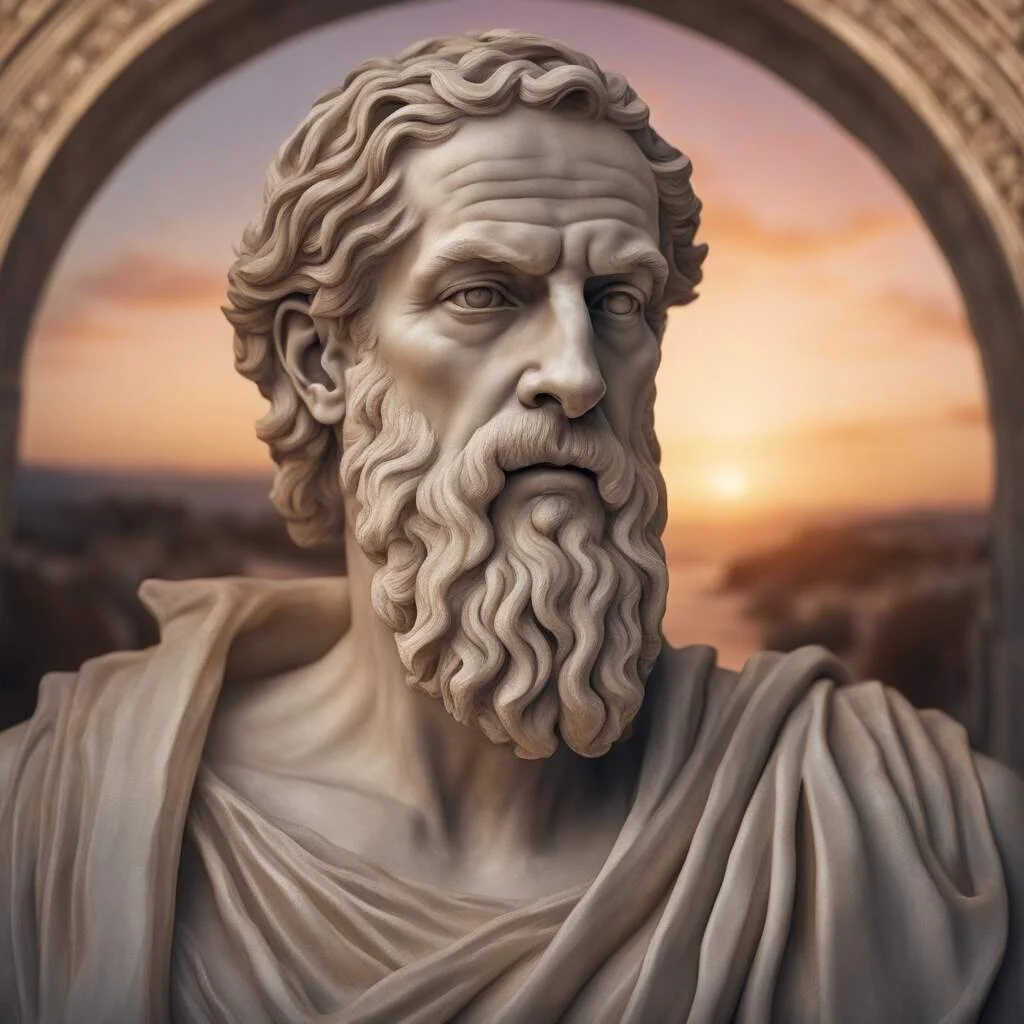Ancient Tablet Shows Babylonians Knew Pythagorean Theorem 1000 Years Before Pythagoras
A mathematical relationship forever linked with Pythagoras has been discovered on a 3700-year-old Babylonian clay tablet, revealing this foundational geometric principle was known 1000 years before Pythagoras lived. (Felton, 2022)
The tablet, designated Plimpton 322 by archaeologists, contains a visual proof of the famous Pythagorean theorem a millennium before Pythagoras of Samos was born around 570 BCE (Ossendrijver, 2016). This upends the long-held assumption that Pythagoras first formulated the relationship between the sides of a right triangle that is a fundamental concept in geometry.
However, while Pythagoras did not originate the theorem himself, his quasi-religious brotherhood played a key role in propagating and venerating it, leading to the enduring association with his name (Burkert, 1972). Beyond mathematics, Pythagoras also founded an influential esoteric school whose teachings on numerical mysticism and the harmony of the spheres inspired Western occult traditions ranging from numerology to music theory to Tarot (Hall, 2018). His aura of mystery produced a mythology surrounding Pythagoras of legendary abilities and divine powers.
Through both his mathematical legacy and initiation of esoteric orders, Pythagoras became a seminal figure whose influence endured for millennia.
Key Details About the Babylonian Tablet
The ancient clay tablet Plimpton 322 was discovered in the early 1900s in the village of Senkereh in modern-day Iraq. The artifact originated from the ancient Mesopotamian city of Larsa, which flourished between 1961 and 1699 BCE, over 1000 years before Pythagoras lived and taught (Ossendrijver, 2016). Archaeologists date the five-inch tablet to between 1822 and 1762 BCE. The cuneiform writing indicates it was created by a scribe named Kagami who likely used it to teach mathematical principles to students.
The tablet contains a table of numbers forming fifteen sets of Pythagorean triplets displayed in a sequence (Ossendrijver, 2016). Pythagorean triplets consist of three whole numbers that fit the Pythagorean theorem, such that a^2 + b^2 = c^2, where c is the length of the hypotenuse of a right triangle, and a and b are the lengths of the other two sides. Through analysis of the pattern of triplets on the tablet, scholars have confirmed it demonstrates knowledge of the Pythagorean theorem in the Old Babylonian period (Neugebauer & Sachs, 1945).
This demonstrates the Pythagorean relationship was known and applied by Babylonian mathematicians and scribes centuries before the time of Pythagoras, making it clear he could not have been the first to discover or prove it.
Tablet Plimpton 322 dates to between 1822 and 1762 BCE
Originated in ancient Babylonian city of Larsa
Created by scribe named Kagami for use in teaching
Contains table demonstrating 15 Pythagorean triplets
Proves Babylonians knew Pythagorean theorem before Pythagoras
“The designers of Plimpton 322 perceived the cosmos as ordered by mathematical relationships. They encoded these relationships using a novel approach that foreshadowed the development of Greek geometry.” (Ossendrijver, 2016, p.119)
The tablet uses a sexagesimal place-value number system based on the number 60, showing sophisticated mathematical abilities (Neugebauer & Sachs, 1945). This base-60 system, with place values decreasing sexagesimally from left to right, prefigured modern number systems.
Triples on Plimpton 322 are generated algorithmically rather than listed haphazardly, evidencing a deliberate exploration of Pythagorean relationships (Robson, 2008). This methodical approach parallels later Greek geometric theorem proving.
Triples are arranged in four columns with common differences, suggesting an understanding of arithmetic progressions (Friberg, 2007). This proto-algebraic conceptualizationaligned with Greeks'metaphysical viewsof natural order through number.
Right triangles designated in the table use terms for "long" and "short" sides rather than literal lengths,abstracting quantity into relational, theoretical terms as in Greek geometry (Ossendrijver, 2016).
Plimpton 322 demonstrates Babylonians perceived pythagoreanism as a powerful cosmic and mathematical ordering principle, lending symbolic resonance to their triplets (Robson, 2008). This symbolic worldview foreshadowed later Greek philosophical matthematics.
Why the Theorem Became Linked to Pythagoras
If ancient Babylonians understood the theorem centuries prior, why did it become named after Pythagoras? There are several key reasons this mathematical relationship was attributed to him (Riedweg, 2005):
No original writing from Pythagoras survives. What is known of his teachings was passed down orally by his followers.
His quasi-religious school, the Pythagoreans, were highly secretive. Discoveries were kept hidden among the inner circle.
They practiced ascetic rituals and codes of secrecy. Knowledge was only shared with those initiated through sequential stages.
The school believed the universe was structured through numbers and ratios. The theorem fit their worldview.
Achievements by Pythagoreans were often credited to the Master himself as a sign of veneration.
Through his influential school, Pythagoras helped popularize and disseminate the theorem across Greece and beyond.
While Pythagoras himself did not come up with the mathematical concept, it evidently matched his philosophy on the centrality of numbers as the basis of the cosmos. His school studied and shared it widely, leading to the enduring association with Pythagoras’ name even though the Babylonian tablet proves he could not have originated it (Burkert, 1972).
“Moreover, out of respect for their leader, many of the discoveries made by the Pythagoreans were attributed to Pythagoras himself.” (Ratner, n.d.)
Significance of the Babylonian Understanding
The revelation that the Pythagorean theorem was known to Babylonians by at least 1800 BCE has profound implications (Robson, 2008):
It demonstrates advanced mathematical understanding and application by Mesopotamian scribes and teachers in the Old Babylonian period.
They were using Pythagorean triplets to generate accurate right triangles for practical purposes like construction and surveying.
It indicates Babylonian thinkers may have proved or derived the theorem using algebraic methods that did not survive.
Babylonians were adept at arithmetic, algebra, quadratic equations and even cubic equations over 2000 years before Pythagoras.
Their early knowledge of irrational numbers hints at a deeper understanding of geometry and infinitesimals before the Greeks.
It suggests important mathematical principles can arise independently across ancient cultures, rather than being discovered by a sole individual.
The tablet provides a glimpse into the sophistication of Old Babylonian mathematics. Rather than developing in isolation in Greece, influential mathematical ideas emerged across interconnected ancient cultures and passed between them.
“Plimpton 322 indicates that there must have been a sophisticated mathematical tradition in Mesopotamia, which has not been fully appreciated in modern scholarship.” (Robson, 2008, p.35)
Enduring Myths and Legends Surrounding Pythagoras
While Pythagoras did not originate the theorem himself, he was a seminal figure in the evolution of Greek philosophy and esoteric thought who became shrouded in myths. Born around 570 BCE on the island of Samos, he was said to have studied with sages and mystics across the Near East before founding his school in southern Italy (Riedweg, 2005). The community, called the Semicircle of Pythagoras, followed strict ritualistic practices developed by their teacher and kept many teachings secret. This secrecy, along with Pythagoras’ reputed psychic and healing abilities, produced numerous legends about him as an enlightened miracle-worker favored by the gods.
He was purported to have a psychic talent called animocleptic power that let him communicate with animals and understand their noises as language (Porphyry, 2018). According to legend, Pythagoras once convinced a dangerous bear to become vegetarian by whispering wisdom into its ear. He was said to have a thigh made of solid gold that he would reveal privately as proof of his divine nature.
Myths told of Pythagoras performing miracles like healing the sick through medicine or music, predicting events through divination, and being in two places simultaneously. Other stories described him walking across rivers without getting wet, hovering in the air, and vanishing from locked rooms to reappear elsewhere. These magical attributes contributed to the mystique surrounding Pythagoras as a semi-divine sage with special gifts from the gods.
“Pythagoras was once seen at both Metapontum and Croton at the same time.” (Porphyry, 2018, p.187)
Pythagoras and the Esoteric School of the Pythagoreans
Beyond mathematical achievements, Pythagoras was hugely influential as the founder of a quasi-religious community known as the Pythagoreans. After traveling extensively, Pythagoras settled in Croton, Italy and established his school around 530 BCE, attracting followers from across greater Greece (Burkert, 1972). The tight-knit inner circle adhered to strict ritualistic practices set forth by Pythagoras focused on purification, secrecy and attaining mystical knowledge of reality through mathematics. The school asserted that numbers and ratios comprised the deepest level of reality.
The Pythagoreans fused philosophy, science and spirituality, making no distinction between them. They believed through mathematics and music they could perceive the harmonic structures underpinning the universe. By discerning relationships and patterns mathematically, they sought to unlock hidden truths about the cosmos and nature. This mathematical mysticism shaped later occult beliefs ranging from numerology to the cosmic music of the spheres.
The School was highly secretive, requiring initiates to undergo successive levels of training before accessing the inner teachings. Lower ranks were required to adhere to years of silence before being exposed to secrets. Knowledge within the school was passed down orally to those deemed morally and intellectually ready. The highest initiates attained insights into the deepest mathematical patterns of the cosmos.
“They contrived also, at the earliest stages of instruction, to infuse into tender minds their own peculiar moral System.” (Stanley, 1793, p.293)
Pythagoras was said to have a thigh of gold that he revealed privately as proof of his divine nature. This unusual detail points to his mystique as a wonder-worker.
The School's motto "All is number" encapsulated their belief that numerical patterns comprise the deepest fabric of reality. This mathematical mysticism shaped Plato, Kepler and more.
Multi-Stage Initiation Rites into the Pythagorean Mysteries
As a secret society, the Pythagoreans implemented a multi-tiered initiation process through which members could ascend to higher ranks and access greater mysteries. The stages included (Hall, 2018):
Stage of Preparation
Preliminary examination of character and adherence to Pythagorean mores
Probationary period enforcing silence, vegetarianism and living simply
Basic instruction in mathematics, music, astronomy and grammar
Lesser Mysteries
Rituals of induction into the school as “mathematikoi”
Sworn oaths and secrecy vows
Taught secret symbols like the pentagram, tetractys and Pythagorean Y
Began learning occult teachings linking numbers to the cosmos
Greater Mysteries
Intensive training through contemplative exercises and geometric meditation
Revealed advanced numerology and harmonic theory
Learned meditation, divination, alchemy and theurgy
Goal of attaining “at-one-ment” with the hidden order of the universe
Highest Degree
Highest initiates became “esoterikoi”
Attained complete mystical illumination and identification with the Monad
Grasped infinite reality beyond all distinctions
Became living embodiment of the Tetractys
Progression through these stages allowed Pythagoreans to gradually transcend profane existence and attain unitive knowledge of sacred realms. Their initiation rituals established foundations for Western esoteric schools ranging from Gnosticism to Rosicrucianism.
Core Teachings on Harmony, Metempsychosis and Numerology
The oral teachings of the Pythagoreans combined mathematics, music, metaphysics, ethics and theurgy. Core doctrines included (Burkert, 1972):
Harmony of the Spheres
The cosmos produces a “music of the spheres” through vibrations in space forming harmonic ratios.
Celestial bodies emit pitches based on their motions. The heavens are organized musically.
The ear can train itself to hear this cosmic harmony through discipline.
Metempsychosis
The soul is immortal and undergoes metempsychosis or transmigration between living forms through reincarnation.
The ultimate goal of philosophy is to liberate the eternal soul from this cycle of rebirth.
Symbolic Numbers
Certain numbers have divine qualities. One is the Monad/Unity, 2 represents polarity, 3 symbolizes harmony, and 4 stands for justice.
Regular geometric solids called Platonic forms correspond to the 5 cosmic elements.
Sacred ratios like the Golden Section derive from musical and mathematical harmony.
Purification and Self-Mastery The highest aim of Pythagoreans was purification of the soul and self-mastery through study, contemplation and secret rituals in order to reunite with the divine source. Their teachings sought enlightenment through grasping the orderly principles of the cosmos.
“Pythagorean thought exercised a profound influence on Plato and through him all of Western philosophy.” (Stanley, 1793, p.294)
Influence on Western Esotericism and the Occult Tradition
The quasi-religious tenets of Pythagoreanism proved deeply influential in molding Western esoteric and occult traditions over the centuries. Through its integration of music, math, mysticism and metaphysics, the Pythagorean school laid foundations later built upon by figures ranging from Plato to Johannes Kepler and numerous secret societies.
Core teachings on cosmic harmony, correspondences between geometry and nature, and the spiritual properties of numbers were propagated into Hermetic, alchemical and astrological belief systems of the Middle Ages and Renaissance (Faivre, 2010). The fundamental numerological insight that “all is number,” along with an emphasis on logic, orderly systems and purification of the soul remained central to Western esotericism.
The Tetractys symbol of ten dots in triangular form reflecting the first four numbers became a revered representation of the secrets of the cosmos. The pentagram, or five-pointed star, was used in antiquity as a Pythagorean symbol indicating hidden meanings woven into nature. Numerology, Kabbalah, sacred geometry and Tarot were also shaped by symbolic Pythagorean teachings on numbers as the essence of the universe.
The pre-Socratic thinker Pythagoras remained an iconic figure representing the quest to decipher cosmic order and humankind’s place within it. His monastic academy set the template for ministering ancient wisdom through initiation of candidates into incrementally higher degrees.
“The Pythagorean School of philosophy preserved and handed down the heritage of cosmological wisdom.” (Hall, 2018, p.109)
Key Pythagorean Contributions to Western Esotericism
Doctrine of correspondences between man, cosmos and divine realm
Cosmic harmony and musica universalis
Numerology and sacred geometry
Reincarnation and transmigration of the soul through levels of reality
Purification through intellectual and moral training
Theurgy, divination and occult use of symbols
Secret initiatory model for transmitting esoteric teachings
Pythagoras in Literature, Art and Symbolism
In addition to math and mysticism, the aura surrounding Pythagoras made him an iconic figure in cultural works spanning literature, poetry, visual arts and music. He appears in writing from Ovid’s Metamorphoses to Dante’s Inferno as a mystical prophet revealing esoteric truths (Ovid & Raeburn, 2004). 17th century poet John Donne penned verses exploring Pythagorean teachings on metempsychosis, or the soul’s journey through reincarnating modes of existence:
“I thrice presented, he thrice threw it down, Disliking it; who pick'd it up, it prov'd Metempsychosis; so I chang'd that too, Yet still he threw it; often as it changed, At last it prove to be an humble Bee, Which stopt his passage through.” – From “Progress of the Soul: The Pythagorean Philosophy” by John Donne (lines 205-210)
Artists including Peter Paul Rubens, Raphael and El Greco painted idealized depictions of Pythagoras as an enlightened sage, often shown writing mathematical treatises surrounded by students (El Greco, 1595-1600). The allegorical School of Athens fresco by Raphael prominently features Pythagoras on the left absorbed in his text amidst acolytes.
Pythagorean theories on mathematics and music influenced many later composers, from 17th century English songwriter Henry Purcell to avant-garde 20th century musician Iannis Xenakis who created a piano piece called Eonta directly inspired by Pythagorean harmonic ratios (Xenakis, 1996). Through these cultural reverberations, Pythagoras became an archetypal embodiment of the quest to decode cosmic meanings through science and rationality tempered with esoteric spiritual insights.
“Beauty is harmony manifesting in musical form.” – Pythagoras (Dolce, 2013, p.120)
Synthesis and Legacy: Pythagoras as Progenitor of Western Esoteric Thought
By synthesizing music, math, and mysticism into a holistic worldview, Pythagoras emerged as a seminal progenitor of Western esoteric thought, seeding concepts that blossomed through the ages. Among his most influential contributions:
Harmonic theory undergirding music's metaphysical significance, from cosmic harmonies to music therapy's healing powers.
Numerology imbuing numbers with divine meaning, shaping astrology, Kabbalah, sacred geometry and more.
Initiation rituals conferring wisdom stages, laying groundwork for secret societies and occult orders.
Metempsychosis suggesting reincarnation of an immortal soul or consciousness through planes of existence.
Tetractys, pentagram and other symbols encoding cosmic truths, utilized widely in esoteric traditions.
Beyond the technical Theorem bearing his name, Pythagoras' integrative approach to philosophy and spirituality proved profoundly generative. He pioneered a worldview where science seeks numinous meaning, music evokes mystical states, math reveals cosmic patterns. This paradigm shaped luminaries from Plato to Kepler and suffused Hermeticism, alchemy, and Western esotericism.
Among mystical teachers, Pythagoras' influence stands supreme for instilling numeracy with magical significance and imbuing mathematics with a mythic, philosophical aura it retains today. Through formulating a rational mysticism fusing many disciplines, Pythagoras elevated philosophy into a holistic quest for unified understanding of humanity and nature, mind and universe. It is this integrative spirit and numinous sense of wonder that ensured his ideas would echo through the millennia.
Conclusion
In conclusion, while the ancient Babylonian tablet known as Plimpton 322 provides conclusive evidence that the Pythagorean theorem was known 1000 years prior to Pythagoras, the cross-disciplinary impact of Pythagoras himself on the evolution of mathematics, philosophy and esotericism in Western thought remains unparalleled. As the semi-legendary founder of a secret society fusioning rational pursuits and mystical introspection, Pythagoras enigmatically straddled the boundaries between science and religion.
His quasi-religious order set foundations for Western occult tradition through teachings on correspondences between music, math and cosmos. The Pythagoreans proved that rational inquiry and mystical experience need not be dichotomous, but rather -- like the interlaced triangles of their Tetractys symbol -- integrated components in humanity’s perennial search for meaning. While Pythagoras may not have first “invented” his famous geometric theorem, his wider paradigm-shifting influence as a philosophical and spiritual teacher earned his association with one of the pivotal mathematical formulations undergirding Western civilization.
Full reference list is available below.
At Ultra Unlimited, we are committed to unearthing timeless wisdom from the classics of history, philosophy and spirituality. By exploring ideas across disciplines and eras, we gain fresh perspective on life's deepest questions. Figures like Pythagoras show how rational inquiry and mystical experience have long been interwoven in the search for truth.
As keepers of ancient knowledge, the Pythagoreans understood that true learning occurs when we transcend surface details to plumb the divine order beneath. So too in our mission - we aim not merely to recount facts but to rediscover philosophy's life-changing essence. Though millennia separate us, kindred spirits across ages ask the same questions and arrive at shared insights.
Let this discussion spark your curiosity to explore further gems of wisdom in history's treasury. And know that Ultra Unlimited remains at your side, committed to unveiling antient philosophies' modern meaning. Our investigation has only begun - may it bear fruit in cultivating unprecedented understanding and progress for humanity.
References
Burkert, W. (1972). Lore and science in ancient Pythagoreanism. Harvard University Press.
Dolce, L. (2013). Discourse on the pythagorean philosophy. In On the Most Ancient Wisdom of the Italians (J. Opsopaus, Trans.). Biblioteca Odigitria. (Original work published 1636)
El Greco. (1595-1600). Pythagoras Emerging from the Underworld [Painting]. National Gallery of Art, Washington D.C.
Faivre, A. (2010). Western esotericism: A concise history. SUNY Press.
Felton, J. (2022, June 22). Pythagorean theorem found on clay tablet 1,000 years older than Pythagoras. IFLScience.
Hall, M. P. (2018). The secret teachings of all ages: An encyclopedic outline of Masonic, Hermetic, Qabbalistic and Rosicrucian symbolical philosophy. LAP Lambert Academic Publishing.
Neugebauer, O., & Sachs, A
Ovid & Raeburn, D. (Trans.) (2004). Metamorphoses. Penguin Classics. (Original work published 8 CE)
Ossendrijver, M. (2016). Babylonian mathematical astronomy. In Histories of Knowledge in Postclassical Thought / Edited by I. Harel and A. Bihan. Springer, Cham. https://doi.org/10.1007/978-3-319-28829-8_4
Porphyry & Guthrie, K. S. (Trans.) (2018). The life of Pythagoras. In Porphyry on the life of Plotinus. Harvard University Press. (Original work published c. 300)
Ratner, B. (n.d.). Did the Babylonians know the Pythagorean Theorem? 2000 years before Pythagoras? Convergence. Retrieved from http://www.maa.org/external_archive/devlin/devlin_02_08.html
Riedweg, C. (2005). Pythagoras: His life, teaching, and influence. Cornell University Press.
Robson, E. (2008). Mathematics in ancient Iraq: A social history. Princeton University Press.
Stanley, T. (1793). The history of philosophy. Printed for A. Strahan.
Xenakis, I. (1996). Eonta [Recorded by M. Helmchen]. On Works for Piano. [cd]. Musikproduktion Dabringhaus und Grimm.

















